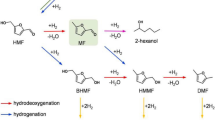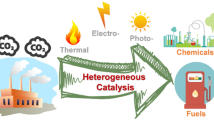Abstract
A new method has been suggested for the preparation of high-octane components from the butane–butylene fraction (BBF) in two stages. At the first stage, the BBF olefins are oxidized with N2O into carbonyl compounds with high selectivity without forming the products of deep oxidation and water. The process occurs in the gas phase in a flow reactor without using a catalyst at a temperature of 400°C and a pressure of 2 MPa with high conversion of both olefins and nitrous oxide. The blending octane number of the oxidation product is 118–133 (RON) and 99–104 (MON). At the second stage, the mixture of carbonyl compounds is hydrogenated with hydrogen in the presence of the Ni/Al2O3 catalyst. The hydrogenation occurs at 150–160°C in a flow reactor in the gas phase. The aldehydes are completely transformed into alcohols, while the ketones can remain in the product under certain conditions. The blending octane number of the hydrogenation product is 111–112 (RON) and 95–96 (MON), which is smaller than for the BBF oxidation product, but larger than for the alkylate obtained in the course of conventional butene alkylation with isobutane (RON is 95–97 and MON is 93–95). Synthesis of high-octane components by this procedure can be useful in practice, especially in productions with huge release of nitrous oxide.
Similar content being viewed by others
References
Kapustin, V.M., Karpov, S.A., and Tsarev, A.V., Oksigenaty v avtomobil’nykh benzinakh (Oxygenates in Automobile Gasolines), Moscow: KolosS, 2011.
Mirzoev, V. and Pishchuk, E., Probl. Mestnogo Samoupravleniya, 2010, no. 41. http://www.samoupravlenie.ru/41-10.php. Cited July 09, 2017.
Badia, J.H., Fité, C., Bringué, R., Ramírez, E., and Cunill, F., Appl. Catal., A, 2013, vol. 468, pp. 384–394.
Jaime-Leal, J.E., Bonilla-Petriciolet, A., Segovia-Hernández, J.G., Hernández, S., and Hernández-Escoto, H., Chem. Eng. Process., 2013, vol. 72, pp. 31–41.
Hazari, N., Iglesia, E., Labinger, J.A., and Simonetti, D.A., Acc. Chem. Res., 2012, vol. 45, no. 4, pp. 653–662.
Simonetti, D.A., Ahn, J.H., and Iglesia, E., J. Catal., 2011, vol. 277, no. 2, pp. 173–195.
Maksimov, A.L., Nekhaev, A.I., Ramazanov, D.N., Arinicheva, Yu.A., Dzyubenko, A.A., and Khadzhiev, S.N., Pet. Chem., 2011, vol. 51, no. 1, pp. 61–69.
Hamadi, A.S., Tikrit J. Eng. Sci., 2010, vol. 17, no. 2, pp. 22–35.
Taraban’ko, V.E., Chernyak, M.Yu., Morozov, A.A., Kaigorodov, K.L., Bezborodov, Yu.N., Orlovskaya, N.F., and Nadeikin, I.V., Zh. Sib. Fed. Univ., Khim., 2014, vol. 7, no. 1, pp. 31–35.
Alotaibi, M.A., Kozhevnikova, E.F., and Kozhevnikov, I.V., J. Catal., vol. 293, pp. 141–144.
Bercaw, J.E., Hazari, N., Labinger, J.A., Scott, V.J., and Sunley, G.J., J. Am. Chem. Soc., 2008, vol. 130, no. 39, pp. 11988–11995.
Panov G.I., Dubkov K.A., and Kharitonov A.S. in Modern Heterogeneous Oxidation Catalysis: Design, Reactions and Characterization, Mizuno, N., Ed., Weinheim: Wiley-VCH, 2009, pp. 217–252.
Starokon, E.V., Dubkov, K.A., Babushkin, D.E., Parmon, V.N., and Panov, G.I., Adv. Synth. Catal., 2004, vol. 346, nos. 2–3, pp. 268–274.
Hermans, I., Moens, B., Peeters, J., Jacobs, P., and Sels, B., Phys. Chem. Chem. Phys., 2007, vol. 9, no. 31, pp. 4269–4274.
Hermans, I., Janssen, K., Moens, B., Philippaerts, A., Van Berlo, B., Peeters, J., Jacobs, P.A., and Sels, B.F., Adv. Synth. Catal., 2007, vol. 349, no. 10, pp. 1604–1608.
Newman, S.G., Lee, K., Cai, J., Yang, L., Green, W.H., and Jensen, K., Ind. Eng. Chem. Res., 2015, vol. 54, no. 16, pp. 4166–4173.
BASF starts up a new production facility for intermediates. http://www.chemicalonline.com/article.mvc/BASFStarts-Up-A-New-Production-Facility-For-0001. Cited July 10, 2017.
Uriarte, A.K., Stud. Surf. Sci. Catal., 2000, vol. 130, pp. 743–748.
Evonik Official Website. http://corporate.evonik.com/ en/products/search-products/pages/product-details.aspx?pid=60222&pfsearch=o&pfcmd=letter. Cited July 10, 2017.
Su, M.-D., Liao, H.-Y., Chung, W.-S., and Chu, S.-Y., J. Org. Chem., 1999, vol. 64, no. 18, pp. 6710–6716.
Avdeev, V.I., Ruzankin, S.Ph., and Zhidomirov, G.M., Chem. Commun., 2003, vol. 9, no. 1, pp. 42–43.
Avdeev, V.I., Ruzankin, S.F., and Zhidomirov, G.M., Kinet. Catal., 2005, vol. 46, no. 2, pp. 177–188.
Kirmse, W.M., Carbene Chemistry, New York: Academic Press, 1964
Nefedov, O.M., Ioffe, A.I., and Menchikov, L.G., Khimiya karbenov (Carbene Chemistry), Moscow: Khimiya, 1990.
Emel’yanov, V.E. and Skvortsov, V.N., Motornye topliva. Antidetonatsionnye svoistva i vosplamenyaemost' (Motor Fuels: Antiknock Properties and Inflammability), St. Petersburg: Tekhnika. TUMA GRUPP, 2006.
Reference Data for Hydrocarbons and Petro-Sulfur Compounds, Bartlesville, OK: Philips Petroleum Company, 1945.
TR TS (Customs Union Technical Regulation) 013/2011: Requirements to Automobile and Aviation Gasoline, Diesel and Ship Fuel, Jet Engine Fuel and Furnace Boiler Oil, 2011.
GOST R (Russian State Standard) 52033-2003: Motor Vehicles with Gasoline Engines. Emissions of the Exhaust Gas Pollutants. Norms and Methods of Control for the Estimation of Technical State, 2003.
Kapustin, V.M. and Gureev, A.A., Tekhnologiya pererabotki nefti (Oil Refining Technology), vol. 2: Destruktivnye protsessy (Destructive Processes), Moscow: KolosS, 2007.
Parmon, V.N., Panov, G.I., Uriarte, A., and Noskov, A.S., Catal. Today, 2005, vol. 100, nos. 1–2, pp. 115–131.
Author information
Authors and Affiliations
Corresponding author
Additional information
Original Russian Text © A.S. Kharitonov, D.P. Ivanov, M.V. Parfenov, L.V. Piryutko, S.V. Semikolenov, K.A. Dubkov, V.Yu. Pereima, A.S. Noskov, D.O. Kondrashev, A.V. Kleymenov, O.S. Vedernikov, S.E. Kuznetsov, V.V. Galkin, P.A. Abrashenkov, 2017, published in Kataliz v Promyshlennosti.
Rights and permissions
About this article
Cite this article
Kharitonov, A.S., Ivanov, D.P., Parfenov, M.V. et al. New methods for the preparation of high-octane components from catalytic cracking olefins. Catal. Ind. 9, 204–211 (2017). https://doi.org/10.1134/S2070050417030060
Received:
Published:
Issue Date:
DOI: https://doi.org/10.1134/S2070050417030060




